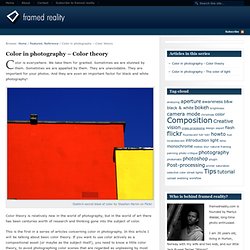

Color in photography - Color theory. Color is everywhere.

We take them for granted. Sometimes we are stunned by them. Sometimes we are appalled by them. They are unavoidable. They are important for your photos. Color theory is relatively new in the world of photography, but in the world of art there has been centuries worth of research and thinking gone into the subject of color. This is the first in a series of articles concerning color in photography. Back in the days Sunny autumn colors... by Marius Waldal of black and white film, photographers were able to extensively process their photos in the darkroom, which was a science and art in itself.
Now in the digital age, the power is back with the people. But color in photography is not just about the power of digital post-processing tools. Three parameters to color Hue Hue is what most people actually mean when they say “color”. Primary hues Color theory has existed for centuries in art. RYB color wheel (from Wikimedia Commons) Saturation Brightness Advancing vs receding colors. Basic Color Theory. Color theory encompasses a multitude of definitions, concepts and design applications - enough to fill several encyclopedias.

However, there are three basic categories of color theory that are logical and useful : The color wheel, color harmony, and the context of how colors are used. Color theories create a logical structure for color. For example, if we have an assortment of fruits and vegetables, we can organize them by color and place them on a circle that shows the colors in relation to each other. The Color Wheel A color circle, based on red, yellow and blue, is traditional in the field of art. There are also definitions (or categories) of colors based on the color wheel.
Primary Colors: Red, yellow and blueIn traditional color theory (used in paint and pigments), primary colors are the 3 pigment colors that cannot be mixed or formed by any combination of other colors. Secondary Colors: Green, orange and purpleThese are the colors formed by mixing the primary colors. What Makes a Good Photograph? A couple days ago I asked a question on Twitter that got a lot of different and refreshing responses.

I asked “If you had one word, what would you say makes a good photograph?”. Here are some of the answers I got: inspiration, passion, persistence, timing, perception, captivating, feeling, emotion, impact, story, and composition. Tweeple – well said! Now, in more than one word, we have for you 10 Elements that Make a Great Photograph. This article is brought to you by Jana Morgan, a talented photographer located in Hawaii. 1. Creating depth is simple when you are in full control of your camera in manual mode. What Makes a Great Photograph. Home Donate New Search Gallery Reviews How-To Books Links Workshops About Contact The Secret: What Makes a Great Photo © 2013 KenRockwell.com.

All rights reserved. Ruin, San Diego, 28 July 1996. enlarge. This free website's biggest source of support is when you use those or any of these links when you get anything, regardless of the country in which you live — but I receive nothing for my efforts if you buy elsewhere. I'm not NPR; I get no government hand-outs and run no pledge drives to support my research, so please always use any of these links for the best prices and service whenever you get anything. July 2013 Better Pictures Nikon Canon Fuji LEICA All Reviews Better Pictures: The Secret Composition Simplicity FART Shadows Lighting Adjustments It's Not Your Camera Exposure WB Don't Worry: Shoot Introduction top Intro Basics Performance Usage Recommendations This is the most important article on this website. These fundamentals are mandatory knowledge to all artists. The Basics top Eye Path. ESSENTIALS For Photographers. Photoshop Layers Tutorials - The Background Layer.
Written by Steve Patterson. In the previous tutorial, we learned the essential skills for working with layers inside Photoshop's Layers panel . We learned how to add new layers, delete layers, move layers above and below each other, how to add adjustment layers and layer styles, change a layer's blend mode and transparency level, and much more, all from within the Layers panel! But before we get into more of the amazing things we can do with layers, there's one special type of layer we need to look at, and that's the . The reason we need to learn about it is because there's a few things we can do with normal layers that we can't do with the Background layer, and if we're not aware of them ahead of time, they can easily lead to confusion and frustration.
Download our tutorials as printable PDFs! Here's an image of a photo frame that I've just opened in Photoshop. The original image. The Layers panel showing the image on the Background layer. Selecting the Move Tool from the Tools panel. Digital Photography Tips and Tutorials. Adobe TV.